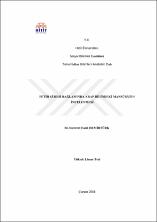Fetih sûresi bağlamında Arap dilindeki mansûbâtın incelenmesi
Citation
Demirtürk, M. F. (2018). Fetih sûresi bağlamında Arap dilindeki mansûbâtın incelenmesi (Yüksek Lisans Tezi).Abstract
Şüphesiz ki bir metnin iyi bir şekilde anlaşılabilmesi yazılı olduğu dili iyi bir şekilde bilmeye bağlıdır. Kur'ân-ı Kerim, Hadis-i Şerif ve diğer İslâmî kaynakların Arapça olması, Arapça'nın iyi bir şekilde bilinmesini gerekli kılmıştır. Yüce kitabımız Kur'ân-ı Kerim'in anlaşılması için birçok farklı ilim dalı bulunmaktadır. İslâm âlimleri tefsir, esbâb-ı nüzul, belağat, sarf, nahiv, kıraat, mecâz, üslûb, iʿrâb vb. birçok farklı ilimle Kur'ân-ı Kerim'i anlamaya ve anlatmaya çalışmışlardır. Mansûbât Arapça cümle yapısında önemli bir konuma sahiptir. Mefʿûller ise Mansûbâtın aslını oluşturmaktadır. Mefʿûller; Mefʿûlün bih, Mefʿûlün leh, Mefʿûlün fih, Mefʿûlün meah, Mefʿûlü Mutlak olmak üzere beş kısımdır. Asıl olan mefʿûllere benzeyenler ise münâdâ, hâl, temyiz, müstesnâ, كَانَ ve kardeşlerinin haberi, ظَنَّ ve kardeşlerinin mefûlleri, كَادَ ve kardeşlerinin haberi, إنّ ve kardeşlerinin ismi, cinsini nefyeden lâ'nın ismi, لَيْسَ 'ye benzeyen mâ ve lâ'nın haberidir. Fiili muzari de başında nasbedici edatlardan birisi bulunması durumunda mansûb gelmektedir. Sıfat, Tekîd, Atıf, Bedel, Atf-ı beyân olmak üzere beş kısımda incelenen tâbiler ise öncesindeki kelimeye iʿrâb açısından tâbi olmaktadır. Bundan dolayı mansûb bir kelimeye tâbi olanlar da Mansûbâttandır. Çalışmamızda Mansûbâtı teorik olarak inceleyip daha sonra da bu konuları Fetih sûresi bağlamında değerlendireceğiz. Bu çalışmamızın hayırlara vesile olmasını Allah Azze ve Celle'den niyaz ediyorum. There is no doubt that the understanding of a text completely goes through knowing its language very well. The Qur'an, and the Prophetic traditions are in the ʿArabic language which is encouraging us to learn the ʿArabic language very well. İn order, to understand our holy book -the Qur'an- there are various scientific areas. İslâmic scholars have tried to understand the Qur'an through many scientific areas such as tafsir (interpretation), esbâb-ı nüzul (reasons of revelation), belağat (rhetoric), sarf and nahiv (grammar), Kıraat (recitation), mecâz (metaphor), üslûb (method), iʿrâb (expression). This helps to understand the Qur'an much better. The Mansûbât (accusatives) have an important role in the shape of an ʿArabic sentence. So there are objects called Mefʿûls which are the basic elements of the Mansûbât. However, the Mefʿûls are 5 as follows: Mefʿûlün bih (an accusative object), Mefʿûlün leh (adverbal qualification of purpose), Mefʿûlün fih (adverbal qualification of time and place), Mefʿûlün meah (which tells about the event happening next to the act), Mefʿûlü Mutlak (cognate accusative-the absolute object). There are also others which can be regarded as the side elements of these basics as follows: münâdâ (called), hâl (to remove the ambiguity of the basic items), temyiz (to remove the ambiguity of the person), müstesnâ (espective), the predicate of كَانَ and its sisters, the predicate of كَادَ and its sisters, the Name of إنّ and its sisters, the name of lâ which negates its type, the predicate of mâ and lâ which look like لَيْسَ. The Present tense is also a mansûb. There are also the so-called followers which are always following their formers in grammar ruling such as: sıfat (the adjective), tekîd (added word for emphasis), atıf (the concunction), bedel (the substitute), atf-ı beyân (another type of the concunction). Therefore, anything follows the Mansûbât in ruling are also called likewise. In this work we will analyse the Mansûbât theoretically and will try to examine it on sûrah Fath. We ask Allah (swt) to make this work beneficial.


















